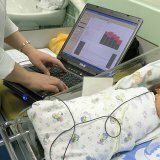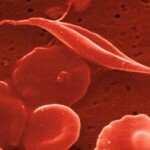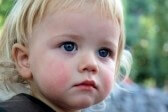How to identify hearing problems in a newborn

Hearing impairment is a common pathology among the entire population of the planet. The frequency of its occurrence is constantly growing, and the highest growth rate has been observed in recent decades. Timely diagnosis of deafness and deafness is a topical issue in medicine and sociology, as the child's hearing quality depends on his speech abilities. But how to identify hearing problems in a newborn?
Hearing problems: diagnosis
The first evaluation of a child's hearing is given by a pediatrician or otorhinolaryngologist on the basis of a parent's survey.
At the age of up to 4 months with normal development of hearing, the baby should wake up, start, cry with unexpected loud sound.
In 4-7 months the child should make attempts to turn to the sound source. It is necessary to observe the nature of his voice.
A child of 7-9 months should normally determine the source of the sound.
In 9-12 months the child must localize sound outside his field of vision, speech sounds should appear.
In 1-2 years - should pay attention to the ability of the baby to hear speech, not seeing the speaker. You should observe his response sounds, vocabulary.
To determine behavioral reactions in hearing research, newborns( up to 1 year old) use sounding toys, a sound proof meter that reproduces intermittent sounds of the same frequency, broadband and narrow-band noises of varying intensity.
The child reacts with various reactions: an unconditional orienting reflex( Moro reflex) - spreads his arms and makes hugging movements;"Freezing" or fading of the body;Face grimaces( closes his eyes, frowns);Wide opening of the eyes;Turn your head to the sound source or vice versa;A slight tremor in the body upon awakening;Sucking movements;Changes in the rhythm of the pulse, breathing, etc.
Three types of answers are given special importance: hearing( that is, behavior in response to a sound signal), listening( turning toward sound, listening), and reflex reactions.
Newborns are examined by a doctor during a light sleep( 1 hour before or after breastfeeding).The child is laid on a hard mattress so that the head lies straight and free, hands and feet are free. The occipital mound prevents the newborn baby from turning his head, so after he turns his head to the sound, you should put it back on the back of the head. The test is started by stimulation of the right ear, then left. This is due to the fact that most children react to sound more often with the right ear. A positive reaction is considered if the child responds to sound 3 times. This technique allows you to determine whether the baby hears or not. In children from 7 months of age and older, the motor reaction should be relatively fast. For babies over 10 months in the method used tonal parcels and noise signals. Turning the head in the direction of the sound should be fast. With a one-sided hearing loss, the baby turns only toward the healthy ear, regardless of the location of the source of sound.
Audiological examination
It is carried out in the surgical center for suspected hearing loss with the following methods:
Acoustic impedance measurement .Registers the index of acoustic conductivity or resistance of the sound-conducting apparatus of the hearing system. A tympanogram and an acoustic reflex are recorded. This method allows you to identify a newborn deafness and determine its nature.
Called otoacoustic emission( VOE) .This method is used for screening newborns and toddlers of the first years of life. VOEE is the recording of very weak sound waves in the external auditory canal with the aid of a highly sensitive microphone. Recorded sound vibrations are generated by the inner ear in response to stimulation by sound.
Computer audiometry for auditory evoked potentials. The method is based on recording the biopotentials of the auditory system, which appear with acoustic stimulation of the hearing organs. This method determines the objective threshold of hearing. A hearing test in a newborn with risk factors for deafness and hearing loss should be conducted in two or three ways.



